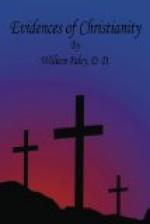The short reply of our Lord to Mary Magdalen, after his resurrection (John xx. 16, 17), “Touch me not, for I am not yet ascended unto my Father,” in my opinion must have been founded in a reference or allusion to some prior conversation, for the want of knowing which his meaning is hidden from us. This very obscurity, however, is a proof of genuineness. No one would have forged such an answer.
John vi. The whole of the conversation recorded in this chapter is in the highest degree unlikely to be fabricated, especially the part of our Saviour’s reply between the fiftieth and the fifty-eighth verse. I need only put down the first sentence: “I am the living bread which came down from heaven: if any man eat of this bread he shall live for ever: and the bread that I will give him is my flesh, which I will give for the life of the world.” Without calling in question the expositions that have been given of this passage, we may be permitted to say, that it labours under an obscurity, in which it is impossible to believe that any one, who made speeches for the persons of his narrative, would have voluntarily involved them. That this discourse was obscure, even at the time, is confessed by the writer who had preserved it, when he tells us, at the conclusion, that many of our Lord’s disciples, when they had heard this, said, “This is a hard saying; who can hear it?”
Christ’s taking of a young child, and placing it in the midst of his contentious disciples (Matt. xviii. 2), though as decisive a proof as any could be of the benignity of his temper, and very expressive of the character of the religion which he wished to inculcate, was not by any means an obvious thought. Nor am I acquainted with anything in any ancient writing which resembles it.
The account of the institution of the eucharist bears strong internal marks of genuineness. If it had been feigned, it would have been more full; it would have come nearer to the actual mode of celebrating the rite as that mode obtained very early in the Christian churches; and it would have been more formal than it is. In the forged piece called the Apostolic Constitutions, the apostles are made to enjoin many parts of the ritual which was in use in the second and third centuries, with as much particularity as a modern rubric could have done. Whereas, in the history of the Lord’s Supper, as we read it in Saint Matthew’s Gospel, there is not so much as the command to repeat it. This, surely, looks like undesignedness. I think also that the difficulty arising from the conciseness of Christ’s expression, “This is my body,” would have been avoided in a made-up story. I allow that the explication of these words given by Protestants is satisfactory; but it is deduced from a diligent comparison of the words in question with forms of expression used in Scripture, and especially by Christ upon other occasions. No writer would arbitrarily and unnecessarily have thus cast in his reader’s way a difficulty which, to say the least, it required research and erudition to clear up.




